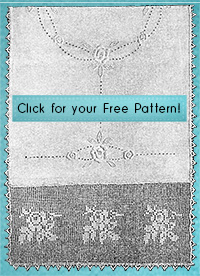Decorating Guest Towels with Crochet Insertions
“The pretty custom of offering an especially attractive towel to a guest comes to us from Japan—where politeness is said to be a national virtue.” (1918)
For a quick one-of-a-kind gift, you can decorate a pair of purchased hand towels with crocheted insertion. You only need to decorate one end of the towel. 100% cotton crochet thread is sturdy stuff, so your finished gift will be easy to care for and can even be machine washed in hot water.
Step 1: Purchase the towels. Choose plain towels that aren’t already decorated. You can use single-color towels or prints. Any sort of nap or fluffiness will work, but more high-end fabric would be best. Whatever you choose, remember that your crochet will outlast the fabric!
Step 2: Choose your thread. Use thread that will match the thickness of the towel fabric, at least size 10 or even size 5. Use good quality name-brand thread. Some ideas for color:
- Match the color of the towel for a subtle elegant effect
- Use a contrasting color like ecru over burgundy or blue over light green
- Match the color of the towel, but use a lighter or darker shade of thread
Step 3: Choose your pattern. Your insertion should be 1” to 3” wide, so a simple filet pattern with 10-25 squares would work best. Work a small sample to check your gauge.
Step 4: Crochet! Make your insertion till it’s the width of the towel, then stop. Use good sturdy knots to secure your thread at the beginning and end, and weave in your ends.
Step 5: Sew the insertion to the towel. Pin your insertion to the towel, about 1” to 3” away from the edge, and machine stitch all around the insertion.
Step 6: Pat yourself on the back, because you’re finished!
The insertion may shrink with the first washing, but that’s okay because it will add a bit of pretty ruffling to the towel. Your crochet will stand up to machine washing since you made good knots to prevent raveling, and your giftee won’t need to worry about taking special care of the towels in the laundry.











